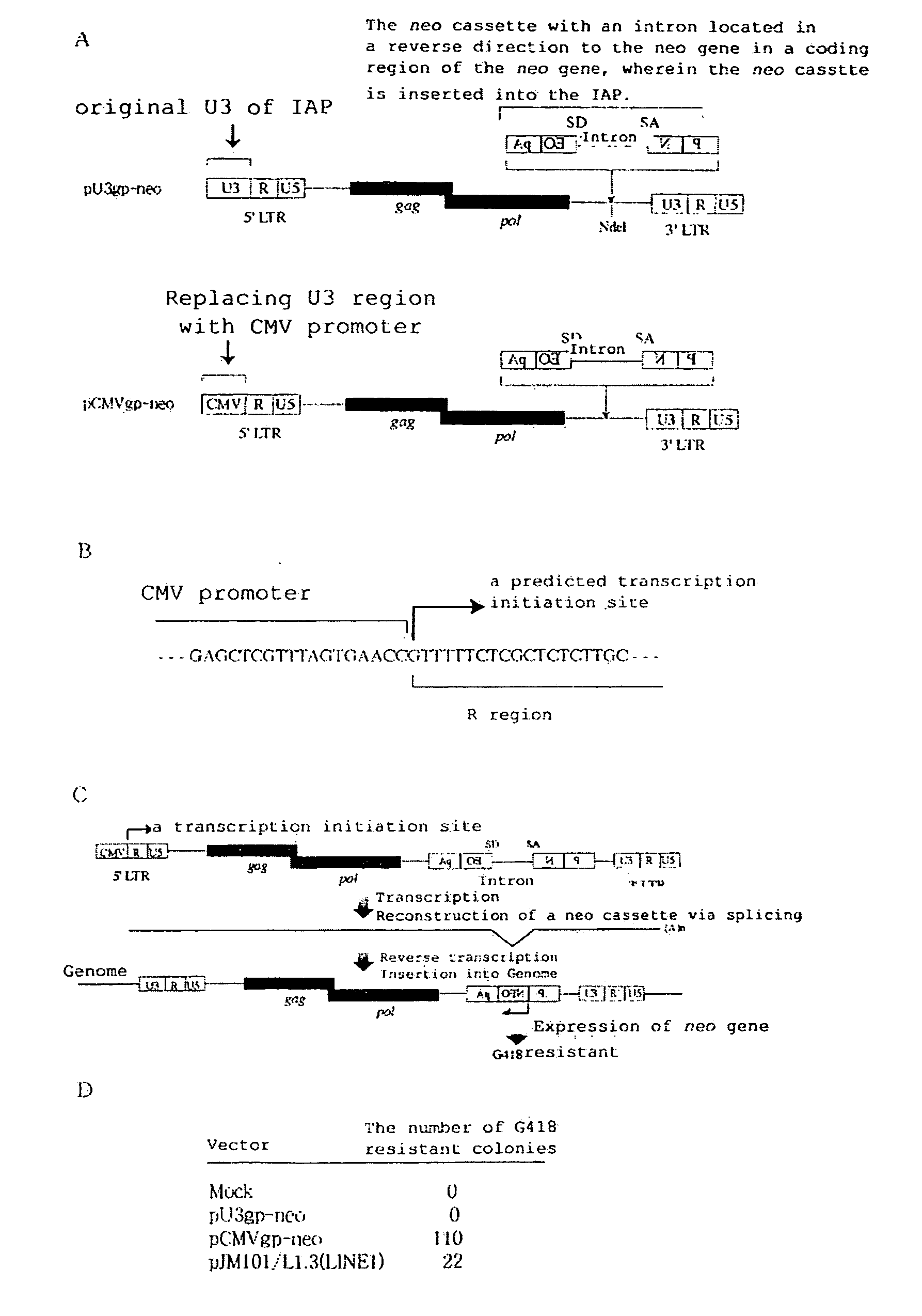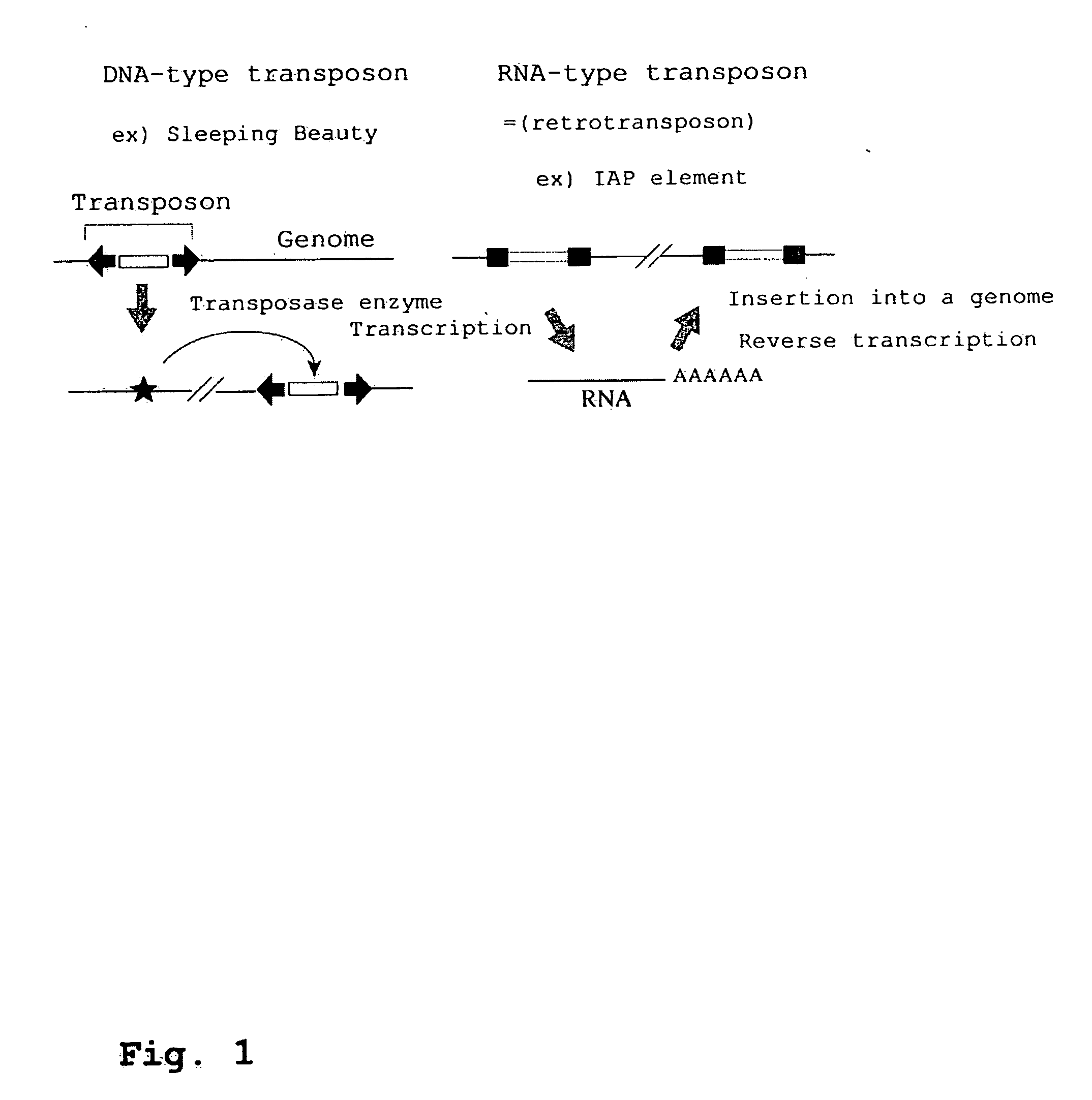Development of Mammalian Genome Modification Technique Using Retrotransposon
a genome modification and retrotransposon technology, applied in the field of development of mammalian genome modification technique using retrotransposon, can solve the problems of insufficient amount of nucleic acids to be introduced, inconvenient promotion of transgene integration, and insufficient development of efficient transgene production methods. achieve the effect of promoting transposition and confirming transposition activity
- Summary
- Abstract
- Description
- Claims
- Application Information
AI Technical Summary
Benefits of technology
Problems solved by technology
Method used
Image
Examples
example 1
Construction of IAP
[0382]1. Production of IAP vector
[0383](a) Isolation of the full-length IAP sequence from the genome
[0384]Amongst the leukemia cells induced by radioactive radiation to C3H / He mice, cells which have been observed to have transposition of the IAP, which had been believed to be full length amongst the base sequences (8065-AML cells, Ishihara & Tanaka, FEBS Lett. 418, 205-209, 1997) were used to isolate the IAP by means of PCR. Firstly, outside the genomic region of the IAP sequence, the following two primers were selected: 5′-GCAGCGGCCGCCGTGGTGGCACACACTTTTAGTCCCCGCAG-3′ (SEQ ID NO: 9) and 5′-GGCGCACTAGTGATGCCCTCTCAGGCCTCCACTCAGGCACT-3′ (SEQ ID NO: 10). Each has introduced NotI and SpeI, restriction enzyme sites which are not present in the PCR products, at the 5′ terminus thereof. Conditions of PCR are as follows: 94° C.×two minutes, (94° C.×15 seconds−65° C.×30 seconds−68° C.×six minutes) for ten cycles, (4° C.×15 seconds−65° C.×30 seconds−68° C.×(six minutes+five ...
example 2
Transfection (Introduction of a Vector into a Cell) and Drug Selection)
[0397]One day prior to transfection, 250,000 cells were plated in a six-well culture plate. Transfection was achieved by using 1.5 μg DNA using Effectene (QIAGEN) against a NIH 3T3 cell, and 4 μg of DNA in a HeLa cell, using LipofectAMINE (Invitrogen). Selection by means of G418, was initiated after 4-7 day passage of a cell after the transfection. The concentration of G418 used are 500 μg / ml against NIH 3T3, and 600 μg against HeLa. 12-14 days after the initiation, the number of G418 colonies have been counted. Fluorescent by means of GFP achieved detection under microscope after post-three day after the transfection.
[0398](Results)
[0399]The results of the Examples are shown in FIGS. 3C, 4 and 5.
[0400]FIG. 4C depicts the principle of detection of transposition. Transcription and splicing result in the reconstitution of the neo gene by deletion of introns in the neo cassette. At this stage, the transcription and ...
example 5
Production of hr GFP Cassette and Insertion into IAP Vector
[0414]Next, an exemplification using the GFP gene is presented as a foreign gene.
[0415]A gamma-globin intron in the neo cassette of the previously described pJM101 / L1.3 was inserted between the 192 base of the hrGFP gene (Stratagene) and the 193 base thereof (the base A of ATG, the translation initiation site is defined as the first base), in a reverse direction in terms of the hrGFP gene. Further, this hrGFP cassette was inserted into the NdeI site downstream of the pol gene of the previously described pCMVgp, and those having IAP and gamma globin intron in the same forward direction were identified and designated as pCMVgp-hrGFP (FIG. 8).
[0416]The measurement of the GFP expression was conducted using GFP specified Filter (Olympus, Tokyo, Japan) and Olympus fluorescence inverted microscope at ×100-400 magnification.
[0417]FIG. 8 shows an exemplification of visualization of transposition using GFP. (A) The structure of the ve...
PUM
| Property | Measurement | Unit |
|---|---|---|
| Fraction | aaaaa | aaaaa |
| Length | aaaaa | aaaaa |
| Time | aaaaa | aaaaa |
Abstract
Description
Claims
Application Information
 Login to View More
Login to View More - R&D
- Intellectual Property
- Life Sciences
- Materials
- Tech Scout
- Unparalleled Data Quality
- Higher Quality Content
- 60% Fewer Hallucinations
Browse by: Latest US Patents, China's latest patents, Technical Efficacy Thesaurus, Application Domain, Technology Topic, Popular Technical Reports.
© 2025 PatSnap. All rights reserved.Legal|Privacy policy|Modern Slavery Act Transparency Statement|Sitemap|About US| Contact US: help@patsnap.com



